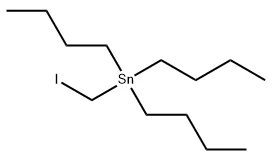- This topic is empty.
-
AuthorPosts
-
2025-10-29 at 2:43 pm #86830
Tributyl(iodomethyl)stannane, CAS No.: 66222-29-5, is a valuable organotin compound widely used as an intermediate in organic and materials synthesis. With the molecular formula C13H29ISn and a molecular weight of 430.98, it appears as a colorless to pale yellow transparent liquid. The compound' s physical properties include a melting point of -22.5 °C, boiling point of 106 °C at 0.05 Torr, density of 1.128 g/cm³, and flash point of 121.7°F. Its high LogP value of 5.81 indicates notable lipophilicity, which plays a role in its behavior during organic reactions.
Due to its chemical activity and sensitivity to environmental conditions, Tributyl(iodomethyl)stannane easily deteriorates when exposed to light, heat, or moisture, leading to gradual color deepening. Therefore, it must be stored in a sealed, dry, and dark environment to maintain its stability and purity. Differences in product appearance may occur depending on purity, manufacturer, and batch conditions. SACH will share the chemical properties, reactivity, synthesis methods, and applications of CAS No.: 66222-29-5 Tributyl(iodomethyl)stannane for sale.

Chemical Properties and Reactivity of Tributyl(Iodomethyl)stannane
Tributyl(iodomethyl)stannane (Cas No.: 66222-29-5) exhibits high chemical reactivity due to the presence of both tin–carbon (Sn–C) and carbon–iodine (C–I) bonds. The combination of these bonds allows it to act as an efficient intermediate in alkylation and coupling reactions. The compound' s iodomethyl moiety serves as a reactive site for substitution, addition, and cross-coupling reactions, while the tributylstannyl group provides both stability and solubility in organic solvents.
These characteristics make it an excellent choice for use as a synthetic building block in the formation of more complex organic molecules, particularly in pharmaceutical chemistry and advanced materials synthesis.
Synthesis Methods of Tributyl(Iodomethyl)stannane
1. Grignard Reagent Method
The Grignard reagent method is a classical approach for preparing Tributyl(iodomethyl)stannane. In this route, a tetrahydrofuran (THF) solution of iodomethylmagnesium chloride (CH₂I–Mg–Cl) is gradually added to a THF solution of tributyltin chloride (Bu₃SnCl). The reaction mixture is stirred at room temperature for several hours and then hydrolyzed to produce the desired compound:
Reaction equation:
CH₂I–Mg–Cl + Bu₃SnCl → Bu₃Sn–CH₂I + MgCl₂
Here, iodomethylmagnesium chloride is obtained through the reaction of methyl iodide and magnesium in anhydrous ether to form the Grignard reagent. However, this method requires strict control of reaction conditions due to the sensitivity of the Grignard reagent, and the overall yield is relatively low.
2. Halogenated Hydrocarbon Replacement Method
A more practical and widely used route is the halogenated hydrocarbon replacement method, in which tributylstannane (Bu₃SnH) reacts with methyl iodide (CH₃I) under high temperature or catalytic conditions:
Reaction equation:
Bu₃SnH + CH₃I → Bu₃Sn–CH₂I + HI
This synthesis pathway is relatively simple to operate and provides better scalability for industrial applications. However, careful control of reaction temperature, catalyst concentration, and reaction time is essential to improve the selectivity and yield of the product.
Applications of Tributyl(Iodomethyl)stannane in Organic Synthesis
In organic synthesis, Tributyl(iodomethyl)stannane (Cas No.: 66222-29-5) serves as a key intermediate for introducing iodomethyl groups into other organic frameworks. This functional group can undergo further transformation through nucleophilic substitution, elimination, or coupling reactions, enabling the construction of complex molecular architectures.
It can also be used as an alkylation reagent, facilitating the formation of carbon–carbon or carbon–heteroatom bonds in fine chemical synthesis. Moreover, the compound plays a role in preparing other organotin derivatives with specialized properties, expanding its utility in synthetic organic chemistry and catalysis.
Tributyl(Iodomethyl)stannane in Drug Synthesis
In the field of pharmaceutical chemistry, Tributyl(iodomethyl)stannane is an important synthetic intermediate for developing drug precursors and active pharmaceutical ingredients (APIs). Its ability to introduce functionalized tin and iodomethyl groups makes it useful in the construction of biologically active molecules, including antiviral and anticancer drug candidates.
During the research and development of new drugs, the compound can participate in key coupling reactions that yield intermediates critical for the formation of active structures. Its controlled reactivity enables precise chemical modifications, which is vital for optimizing the pharmacological properties of drug molecules.
Role of Tributyl(Iodomethyl)stannane in Materials Science
Beyond pharmaceuticals, Tributyl(iodomethyl)stannane (Cas No.: 66222-29-5) has growing importance in materials science. It can serve as a precursor for organotin-based materials used in electronics, photonics, and polymer chemistry. For instance, organotin compounds synthesized from Tributyl(iodomethyl)stannane exhibit desirable electronic and optical properties, making them suitable for semiconductors, sensors, and photovoltaic devices.
Additionally, it can be employed in surface modification processes. Through controlled chemical reactions, the iodomethyl–tin group can be grafted onto various surfaces to alter their hydrophobicity, hydrophilicity, or chemical reactivity. Such surface engineering techniques have potential applications in coatings, adhesives, and nanomaterial interfaces.
Storage and Handling of Tributyl(Iodomethyl)stannane
Given its sensitivity to environmental factors, Tributyl(iodomethyl)stannane must be stored under tightly sealed, dry, and dark conditions to prevent decomposition. Exposure to light, air, or moisture can lead to degradation and color change. The compound should be handled under an inert atmosphere, such as nitrogen or argon, particularly during synthesis or transfer operations.
Commercially, it is available in 1 kg drums, with a minimum assay of 98% purity. Its flash point of 121.7°F requires careful attention during handling to avoid ignition hazards, and appropriate personal protective equipment (PPE) should always be used.
Conclusion:
Tributyl(iodomethyl)stannane is a chemically versatile and functionally rich organotin compound that plays a crucial role in modern organic synthesis, drug development, and materials science. Its unique reactivity profile, stemming from the combination of Sn–C and C–I bonds, enables it to serve as a foundation for advanced molecular construction and surface engineering.
http://www.hzsqchem.com
SACH BIOTECH Co.,Ltd. -
AuthorPosts
- You must be logged in to reply to this topic.